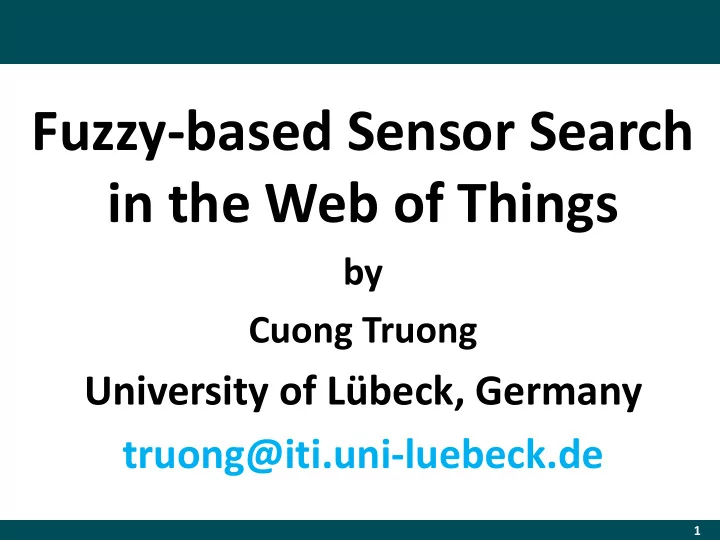

Fuzzy-based Sensor Search in the Web of Things by Cuong Truong University of Lübeck, Germany truong@iti.uni-luebeck.de 1
The Vision of the Internet of Things real world objects will be uniquely identifiable and connected to the Internet 2
The Vision of the Web of Things mashing up sensors and actuators with services and data available on the Web 3
Sensor Search in WoT: Start-of-the-art GSN publish Internet a textual description 傳感器 sensor capteur 4
Sensor Search in WoT: Start-of-the-art complex for end user! 5
Sensor Similarity Search: An Illustration Places that have Pick a climate • What to type in similar climate and sensor in Key West, search engine? oceanic condition and search for • How to describe to Key West in the similar sensors search criteria? last year? Not easy! Hmm! Marathon Key West Fishery owner 6
Sensor Similarity Search: Architecture crawls crawls Internet crawls local database search for: 7
Questions to be addressed How to define and compute similarity I. between two sensors? How to construct a fuzzy set from II. historical sensor readings? How to minimize the cost of storing such III. fuzzy sets? How to efficiently compute a similarity IV. score between a pair of sensors? How to objectively evaluate the V. approach? 8
I. Similarity Definition (1) similar reading curves 20 10 similar 21 (2) similar reading ranges 11 different 125 what about me? 12 9
I. Similar Reading Curves: Captured by Fuzzy Set F 1 K x x 0.9 kitchen library 0.6 48 44 28 time F 35 time L x 0 38 44 48 28 35 Degree of membership of elements of fuzzy set F K (38) = 0.9 F L (38) = 0.6 Key idea: Same value, different degree of memberships in different fuzzy sets 10
I. Similar Reading Curves: Captured by Fuzzy Set F 1 K x x 0.9 kitchen library 0.6 48 44 28 time F 35 time L x 0 38 44 48 28 35 The reading 38 is likely read by sensor in kitchen: F K (38) = 0.9 > 0.6 = F L (38) Given a sensor S with set of readings X = {x}, S is likely located in kitchen if: 11
I. Similar Reading Ranges captured by the reading range difference 12
I. Similarity Computation Given a sensor V , and a sensor S whose set of readings is X = {x} Combining the two above mentioned similarity conditions: Similar reading curves (defined by fuzzy set) Similar reading ranges (defined by reading range difference) 13
Questions to be addressed How to define and compute similarity I. between two sensors? How to construct a fuzzy set from II. historical sensor readings? How to minimize the cost of storing such III. fuzzy sets? How to efficiently compute a similarity IV. score between a pair of sensors? How to objectively evaluate the V. approach? 14
II. Fuzzy Set Construction Temperature sensor S has been monitoring a room for 24 hours from 00:00 -> 23:59 F S (x) x 1 S 30 + + + 24 + + + time x 15 0 00:00 23:59 24 15 30 15
Questions to be addressed How to define and compute similarity I. between two sensors? How to construct a fuzzy set from II. historical sensor readings? How to minimize the cost of storing such III. fuzzy sets? How to efficiently compute a similarity IV. score between a pair of sensors? How to objectively evaluate the V. approach? 16
III. Efficient Fuzzy Set Storage: Approximation + + Fuzzy set‘s storage overhead Membership function is smooth Approximation using set of line segments 17
Questions to be addressed How to define and compute similarity I. between two sensors? How to construct a fuzzy set from II. historical sensor readings? How to minimize the cost of storing such III. fuzzy sets? How to efficiently compute a similarity IV. score between a pair of sensors? How to objectively evaluate the V. approach? 18
III. Efficient Similarity Score Computation f(x) x 19
Questions to be addressed How to define and compute similarity I. between two sensors? How to construct a fuzzy set from II. historical sensor readings? How to minimize the cost of storing such III. fuzzy sets? How to efficiently compute a similarity IV. score between a pair of sensors? How to objectively evaluate sensor V. similarity search? 20
V. Evaluation: Approach For a search, a list of sensors is returned Ranked by decreasing similarity score Similar sensors are ranked on top Issue: „ Similarity “ is highly subjective! no ground truth Fact: Sensors close to each other have similar readings Approach: Group sensors based on location and annotated group with its location 21
V. Evaluation: Approach perform search bedroom List ranked by kitchen similarity score 22
V. Ranked List: Degree of Accuracy 23
V. Evaluation: Multiple Real Data Sets For each data set, group sensors based on location, and define a search trial as Picking a sensor and perform search Compute DOA value of the obtained ranked list For each sensor Last 24 hours of readings are used Evaluation is done on a PC Java VM Intel Core i5 CPU at 2.4 Ghz clock rate 24
IntelLab Data Set http://db.csail.mit.edu/labd ata/labdata.html 12 sensors in 3 groups 1500 data points/24 hours Performance: 222 μ s / pair 4505 sensors / second (brute force) 25
NOAA Data Set http://tidesandcurrents.no aa.gov/gmap3 23 sensors in 5 groups 200 data points/24 hours Performance: 28 μ s / pair 35741 sensors / second (brute force) 26
MavPad Data Set http://ailab.wsu.edu/m avhome/index.html 8 sensors in 2 groups 500 data points / 24 hours Performance: 70 μ s / pair 14285 sensors / second (brute force) 27
Summary Sensor similarity search and distributed architecture to realize it Fuzzy-based approach to efficiently compute similarity score Evaluation metric for ranked list Accurate results of evaluation Outlook: Scalability Paralellize search More efficient similarity computation Index and lookup of fuzzy sets at server side Incremental search accuracy 28
Recommend
More recommend